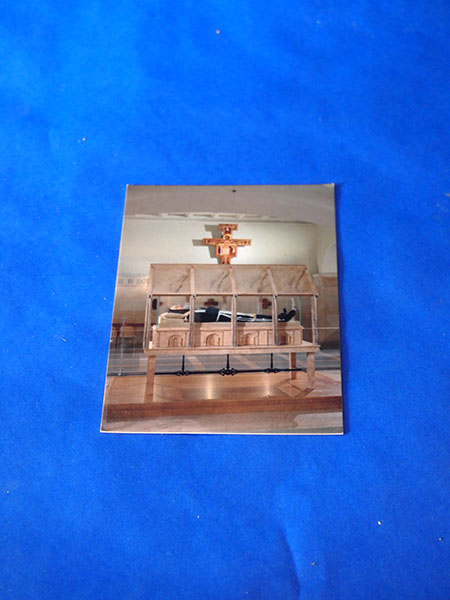![]() body | color | collections | commodity | cube | document | fabric | fetish | gender | glass | home | identity | living | machine | metal | minimal | mobility | narrative | olfactory | organic |
body | color | collections | commodity | cube | document | fabric | fetish | gender | glass | home | identity | living | machine | metal | minimal | mobility | narrative | olfactory | organic |
![]() pain | paper | plastic | plugs | power | protective | rectangular | ritual | round | sound | souvenir | spiritual | style | text-based | time | tool | touch | uniform | value | visual | warm | wood
pain | paper | plastic | plugs | power | protective | rectangular | ritual | round | sound | souvenir | spiritual | style | text-based | time | tool | touch | uniform | value | visual | warm | wood
| Religious: Funeral Memorial Card | |||
Narrative: Funeral memorial card. This card is from a family member's funeral. It was printed in 2010 in the USA. Digital C-prints are the result of printing a digital file on a continuous tone printer that uses silver-based paper. The photograph is created by exposing the paper with light sources (such as lasers or LEDs) and then processing the exposed paper with traditional chemistry. The most common papers are type-C papers processed in RA-4 chemistry. The continuous tone printers include the Lightjet, Durst Lambda, and the Chromira, and labs that make these types of prints will usually advertise that they use one of those three brands. The paper is made up of Silver halide, Resin, Baryta, Polyester, Linen, Polyethylene, Strontium, Amoniac, Silver nitrate (silver bullion or silver foil with nitric acid resulting in silver nitrate, water, and oxides of nitrogen), Gelatin from animal hooves, Sulfur, Alum, Formaldehyd (produced industrially by the catalytic oxidation of methanol), Glyoxal, Saponin (plant-derived from the maple tree, for example), Phenol (from petroleum), Thymol (organic from thyme oil), Antiseptics, Hardeners to improve the physical characteristics of the emulsion during storage and development, a wetting agent to reduce surface tension of the dried emulsion such as Saponin, Stabilizers to prevent development of unexposed grains when the image is developed, Gelatine hardener to prevent the gelatin to swell, Surfactants, lubricants and anti static agents to control the properties of the dried emulsion, color sensitizing dyes to expand the range of light sensitivity, the sensitivity of the emulsion. Chemical waste was sent to: Guiyu, China; India, New Delhi; Pakistan, Karachi; Bantam Island, Indonesia - e waste from Singapore and Malaysia; Indonesia; Nigeria, Lagos; Ghana, Accra; Ghana, Agbogbloshie - outside Accra; India, Bangalore. The thick paper stock was made from pulp obtained by chemical means, known as kraft pulping. Chips of wood were placed in a large, sealed container known as a digester. The digester contained a strongly alkaline solution of sodium hydroxide and sodium sulfide. Bleaching removes lignin and involves mixing the pulp with a series of oxidizing chemicals that react with the lignin. After each mixture, the pulp was washed with an alkaline solution that removes the treated lignin. Fillers were added to the pulp. (A typical filler is a clay known as kaolin. Other chemicals often added to pulp include starches or gums. Rosin and alum are often added as sizers, making the paper less absorbent.) Pulp was added to water to form slurry in order to make paper with an even density. The slurry was pumped onto a moving mesh screen made up of very fine wires of metal or plastic. Water drained through the small openings in the mesh, and formed a sheet of wet material from the slurry. The sheet was moved on a series of belst made of felt containing wool, cotton, and synthetic fibers. |
 |
||
![]()
